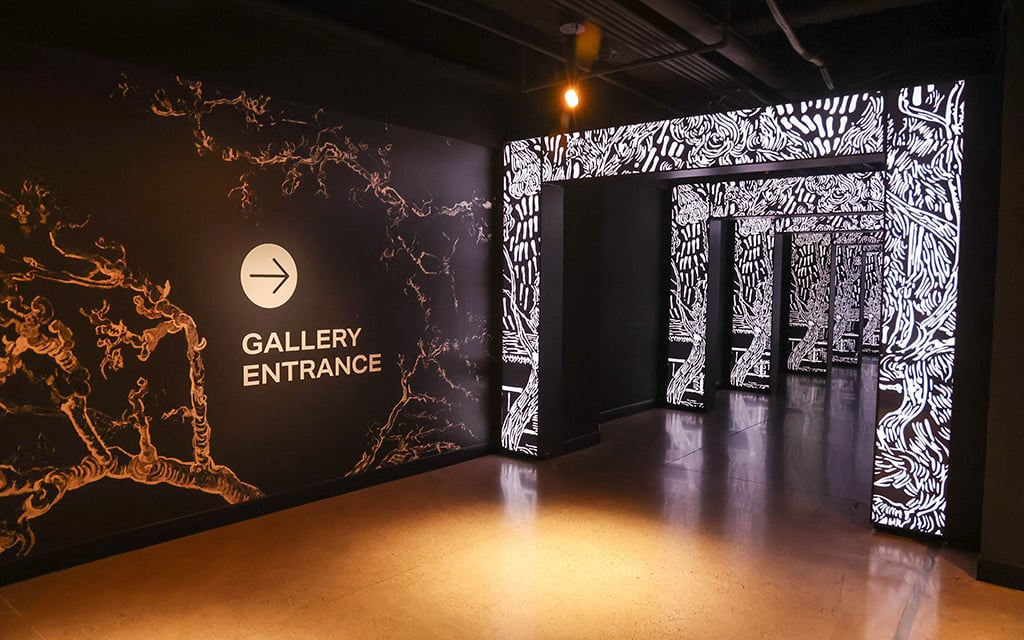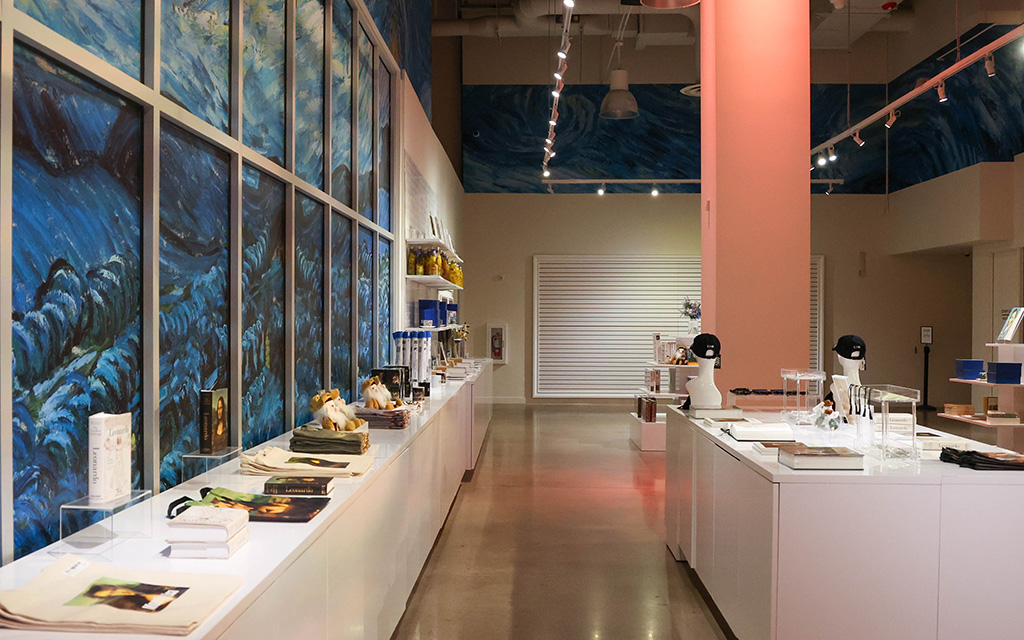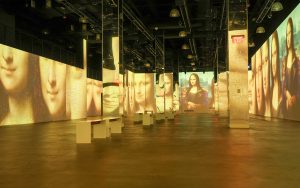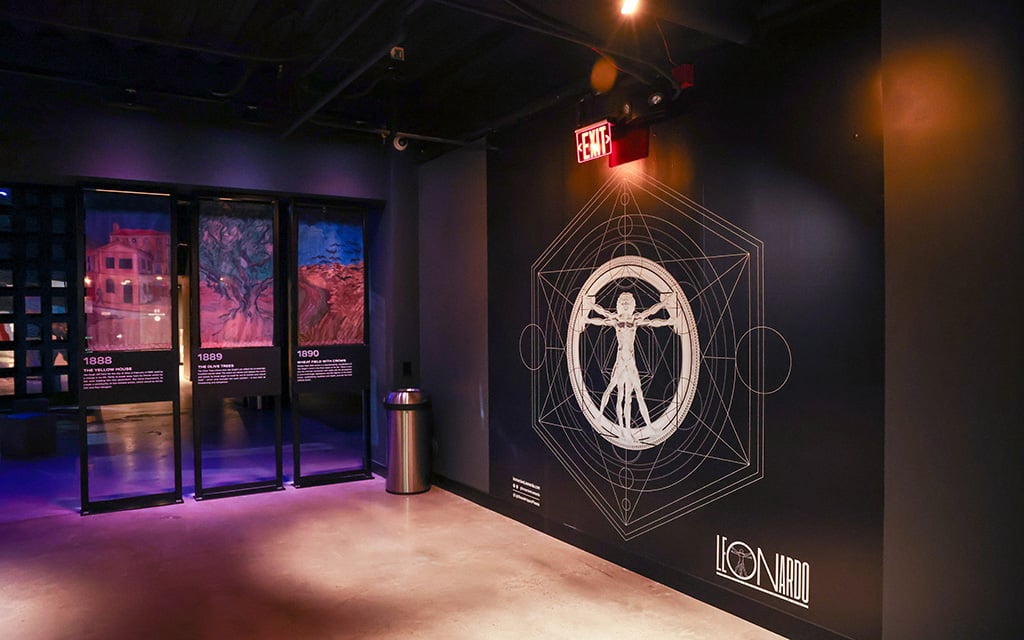
The “Leonardo: The Universal Man” exhibit at Lighthouse Artspace Phoenix in Scottsdale debuted in March and was originally scheduled to run through June, but it will likely extend into July, a spokesman said. (Photo by Evelin Ruelas/Cronkite News)

At the “Leonardo: The Universal Man” exhibit at Lighthouse Artspace Phoenix in Scottsdale, visitors can buy Leonardo-themed items such as bags, shirts and books. (Photo by Evelin Ruelas/Cronkite News)
SCOTTSDALE – “Leonardo: The Universal Man” exhibit – an immersive, 360-degree experience – is on display in Scottsdale, and it’s just one example of an increasingly popular art style. One art history professor at Arizona State University said this digital form is the art world’s next big trend.
The exhibit uses projection mapping, which digitally projects Da Vinci’s greatest works onto the surrounding walls and floors. Complete with music, narration and moving pictures running on a 38-minute loop, the exhibit brings the artist’s works to life.
Heather Bowyer, an art history instructor at ASU’s Herberger Institute for Design and the Arts, said she believes projection mapping is “the new kid on the block in the art world.”
“It’s coming very fast,” Bowyer said. “This is where the shift is coming and is going to continue to build. This is just the first round. We’re going to see more of this as time goes on.”
Though she has not yet seen the Leonardo exhibit, she has seen the immersive Vincent Van Gogh show. These types of shows have popped up in venues across the country – and around the world – with some selling out their tickets.

The Leonardo exhibit digitally projects Leonardo Da Vinci’s greatest works, including the Mona Lisa, onto the surrounding walls and floors while music and narration play. (Photo by Evelin Ruelas/Cronkite News)
The Scottsdale Leonardo show debuted in March and was originally scheduled to run through June, but it will likely extend into July, said Jason Roedl, general manager at Lighthouse Artspace Phoenix, where the show is playing.
Along with the Leonardo immersive experience, the venue also has shown the works of Van Gogh, Claude Monet, Gustav Klimt and other shows, such as “Immersive King Tut” and “Immersive Nutcracker.”
Tickets for Leonardo begin at $24.99 for children and teens and $34.99 for adults. Prices go as high as $299.99 for the VIP “Date Night” experience. Ticket prices for the exhibit are pricier than the more conventional Phoenix Art Museum, where tickets for children and teens are $5 and $23 for adults.
However, Bowyer said there’s a lot of time and effort that is put into these immersive exhibits.
“In a perfect world, I’m a believer that museums should be able to be accessed by everyone, no matter what economic background you come from,” she said. “It’s a little expensive but there’s a lot of overhead that goes with this too, so they at least have to break even on it.”
The shows are expensive to build and produce, Roedl said.
“You’re into the seven figures without question, when it comes to not just the physical projectors and the servers and all of that, but the production of these shows. Each one takes about a year to put together,” Roedl said.
Summers tend to be slower for the venue, Roedl said. But when it is busier, ticket sales average 150 a day – usually much more in the September-to-March busy season. And during the Christmas holiday season, 300 to 500 visitors a day is not unusual, he said.

An Arizona State University art history instructor says immersive art exhibits – such as the “Leonardo: The Universal Man” show – are curated by professionals and experts in the field, so the information has been vetted. (Photo by Evelin Ruelas/Cronkite News)
Both Roedl and a spokeswoman for Impact Museums, which is the company distributing “Leonardo,” declined to share information about the annual revenue for the exhibit.
But Lighthouse Immersive, a company similar to Impact Museums, collectively sold about 4.5 million tickets to its “Immersive Van Gogh” exhibit in cities across the country – and that shakes out to about $250 million in revenue, according to a 2021 MarketWatch article.
The venues also make money from their gift stores. At the Leonardo exhibit in Scottsdale, the most popular items are custom print postcards at $3.99, posters at $9.99 and Taschen art books at $39.99, a spokeswoman for Impact Museums said in an email.
Since Da Vinci’s work is in the public domain, Roedl said there is no ethical conflict in using the art for commerce.
“You can go into Target and probably find a Vincent Van Gogh calendar that somebody else has put out and reaped the benefits of it being in the public domain,” Roedl said. “I think it’s one of those things that we’re accustomed to nowadays. I think we all do it as content creators at one point or another.”
Bowyer said she does not see any ethical concerns with the exhibit.
“You have professionals and experts in the field curating it. So, they’re presenting a set of images of Leonardo’s work, and, because of their training, are able to provide information and ideas that have been vetted through academic circles and discussed for years, and perhaps provide a different perspective than just this profit argument,” Bowyer said.
TWOFIFTYK, a Dutch art production company, created the “Leonardo” experience.
Similar to movie theaters displaying Hollywood movies, Impact Museums has secured the rights to show “Leonardo,” which runs in Los Angeles, Dallas, Houston, Scottsdale and Atlanta, Roedl said.
The New Yorker attributes the popularity in America of this digital art form to the Netflix series “Emily in Paris” which aired in 2020. In the first season, the protagonist visits a digital arts center in Paris displaying “Van Gogh, Starry Night.”
The Vincent Van Gogh exhibit also was popular in Scottsdale.
“Van Gogh was huge,” Roedl said. “We’re actually not showing it right now. I have no idea if it will come back, but it was fascinating. It ran for almost a year and a half.”


